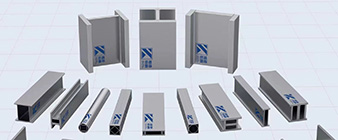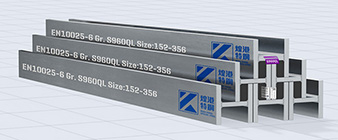S690 steel is increasingly used in super-tall buildings due to its superior strength, lightweight properties and versatility. Here are some of the key applications and benefits of using S690 steel in such structures:
Structural Framework
High strength-to-weight ratio: S690 steel allows for the construction of lighter structural frames, which is crucial for super high-rise buildings. The reduced weight can reduce foundation costs and improve stability.
Tall Columns and Beams: S690’s high yield strength enables the use of slender columns and beams, maximizing available floor space and enabling innovative building designs.
Wind and earthquake resistance
Enhanced stability: The strength of S690 steel contributes to the overall stability of supertall buildings, allowing them to withstand lateral forces generated by wind and seismic activity.
Ductility: The ductility of S690 steel enhances energy absorption during dynamic loading, making it suitable for structures in earthquake-prone areas.
Long span structure
Open Floor Plans: The ability to create long-span beams and trusses using S690 steel facilitates open floor plans, which is ideal in commercial and residential high-rise buildings.
Reduce column interference: Large spaces can use fewer columns, improving the functionality and aesthetics of the building.
Construction efficiency
Modular construction: S690 steel can be prefabricated off-site, allowing for faster on-site assembly, which is critical for high-rise projects with tight deadlines.
Easy to Handle: The lightweight nature of S690 steel components simplifies shipping and handling during construction.
Architectural Flexibility
Innovative Designs: Because of the strength and versatility of S690 steel, architects can explore more creative and complex designs, including cantilevers and unique shapes.
Facade systems: S690 steel can support advanced facade systems, allowing the use of large glass panels and other materials to enhance the aesthetics of a building.
Sustainability Material efficiency: S690 steel’s high strength means less material is required compared to traditional steel grades, reducing the building’s overall carbon footprint.
Integration with other materials
Composite structures: S690 steel can be effectively combined with concrete and other materials to form composite structures that optimize performance and cost.
Hybrid systems: Combining S690 steel with other high-performance materials can increase overall structural efficiency.
Long-term durability
Corrosion resistance: When treated with appropriate protective coatings, S690 steel exhibits excellent corrosion resistance, ensuring the service life of super high-rise buildings.
Maintenance advantages: The durability of S690 steel reduces the need for frequent maintenance, which is beneficial for high-rise structures.
The application of S690 steel in super-tall buildings offers many advantages, including enhanced structural performance, building flexibility and construction efficiency. Its high strength and lightweight properties make it ideal for modern skyscrapers, enabling innovative designs while ensuring safety and durability.
-
 2024-9-16 What are the typical applications of S32205 (2205) and UNS S31803 (2203) duplex stainless steels?
2024-9-16 What are the typical applications of S32205 (2205) and UNS S31803 (2203) duplex stainless steels? -
 2024-9-29 Alloy 59 / 2.4605 Nickel-Based Alloy Structural Profiles: Beams and Columns
2024-9-29 Alloy 59 / 2.4605 Nickel-Based Alloy Structural Profiles: Beams and Columns -
 2024-9-15 What are weather-resistant steel structural hollow profiles?
2024-9-15 What are weather-resistant steel structural hollow profiles? -
 2024-9-16 UNS S31803 stainless steel Hollow Sections and steel profiles of innovative applications
2024-9-16 UNS S31803 stainless steel Hollow Sections and steel profiles of innovative applications -
 2024-9-20 Application of Ti Gr 2 / 3.7035 Structural Hollow Stations
2024-9-20 Application of Ti Gr 2 / 3.7035 Structural Hollow Stations -
 2024-9-20 Ti Gr 7/3.7235/UNS R52400 Application of structural profiles in chemical energy
2024-9-20 Ti Gr 7/3.7235/UNS R52400 Application of structural profiles in chemical energy -
 2024-7-16 Laser welding of advanced high-strength steels (AHSS)
2024-7-16 Laser welding of advanced high-strength steels (AHSS)



